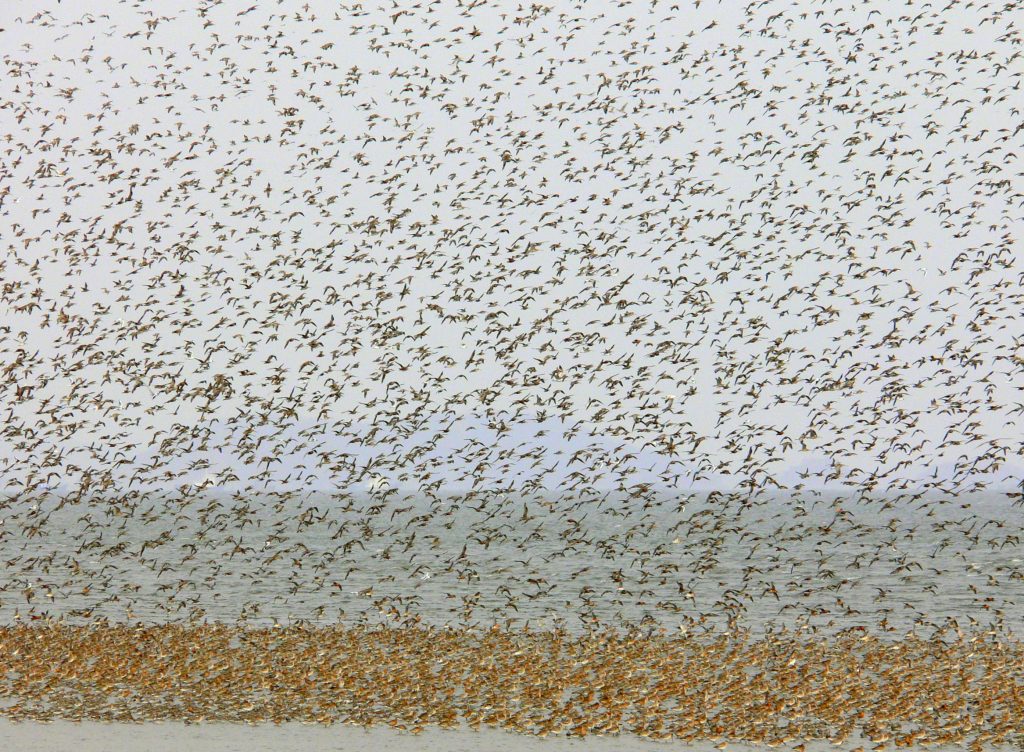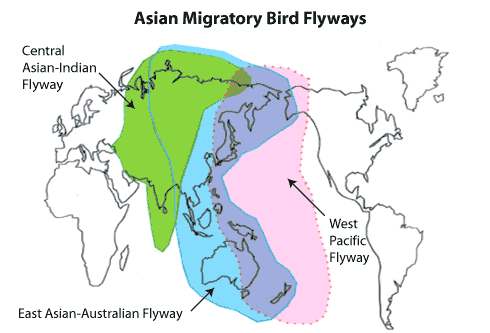
Migratory shorebirds link us all. Bar-tailed Godwits, each year perform massive migration flights between New Zealand and their breeding sites in Alaska. Many other shorebird populations migrate between Australasia and the Arctic tundra. Most of them use stopover sites in the Yellow Sea region of China, Korea, and southern Japan where they refuel. In this way all depend on interlinked habitats throughout their migration routes. Each place is a critically important link in the chain: lose one and the entire system is threatened.
These connections have driven the Shorebirds Centre’s involvement with the East Asian Australasian Flyway (EEAF).
This Page Overview of Shorebird Centre engagement with the Flyway
Page Two Timeline 1970s-1990s
Page Three Timeline 2000-2010
Page Four Timeline 2011-2020
A Focus on Shorebirds
Migratory shorebirds have been a key focus for the Pūkorokoro Miranda Naturalists’ Trust (PMNT) since its foundation in 1975. It was the large flocks gathered on high tide roosts around the Firth of Thames that first attracted the attention of ornithologists such as R.B. Sibson in the late 1940s. Sibson and others, recognising the importance of the site, encouraged the forming of the PMNT with the purpose of eventually establishing an observatory at Pukorokoro Miranda. Since opening in 1990, the Pūkorokoro Miranda Shorebird Centre has gained recognition as a primary source of information and expertise regarding shorebirds, their habitats and coastal ecology in general.

The Importance of East Asia for Migratory Birds
From the late 1980s, in conjunction with similar work in Australia, shorebird banding under the auspices of PMNT began to reveal the east coast of Asia as a major migration route for birds from New Zealand. We now know that for dozens of migratory waterbird populations in the Asia-Pacific region, the Yellow Sea is the lynchpin in their migration strategies. Staging or refuelling sites are essential for ensuring successful migration flights. They allow birds to replenish fuel reserves used after departure from New Zealand, and to arrive on their Arctic breeding grounds with reserves of fat. Such surpluses are essential upon arrival on the tundra where annually variable climate conditions such as snow cover may create initial periods where food is scarce. It also means birds are well placed to commence breeding as soon as conditions allow – an important consideration when the breeding season may last less than two months in some parts of the Arctic.
International Partnerships to Protect the Flyway
Recognition of the critical ecological values of the Yellow Sea region along with other shorebird areas within the Asia-Pacific region, led to establishment of the East Asian-Australasian Shorebird Site Network (EAASSN) in 1996. A partnership of governments and community groups, the Network aimed to ensure appropriate recognition and protection for key sites for migratory waterbirds. PMNT has been engaged with the Network, and its successor – the East Asian-Australasian Flyway Partnership (EAAFP), and with other groups in the region, since the early 1990s.
To date some of our activity has been funded by the Pūkorokoro Miranda Naturalists’ Trust, but the bulk of funding has come from individual members. In 2006 we received a small grant from the Waikato conservancy of DOC. It is worth noting that some funding for early activity by PMNT in the Flyway came from the Australian government. We consider our work in China and Korea has helped meet New Zealand’s obligations under international treaties such as the Convention on Wetlands of International Importance especially as Waterfowl Habitat, commonly known as the Ramsar Convention, and the Bonn Convention on Migratory Species. Consequently, the current engagement of the New Zealand government through the EAAFP since 2011 is warmly welcomed.
Next Page: Timeline 1970s-1990s –>
